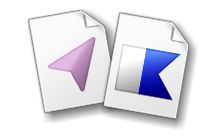NavPoint is a PC Windows software application that is used pre-dive to configure the Artemis Console with geographical locations (navigational waypoints and targets of interest), and post-dive to review data collected by the sonar, and review the route taken by the diver along with additional targets marked during the dive.
NavPoint provides the user with two distinct functions...
Mission Planning
NavPoint is used to create Mission files prior to diving with Artemis, and these are then copied onto its internal memory via the supplied USB cable.
The "Navigation App" on the Artemis console reads the mission file, and displays a geographical chart showing the marked navigational waypoints and targets of interest for the dive.
During the dive, the diver can select a marker from the mission file and the Artemis navigation system will then use position data (from the GPS float) to provide real-time distance and bearing information, helping to navigate them to the target.
The NavPoint application provides several methods for importing (and exporting) position information for the markers, including GPX (GPS eXchange), CSV (Comma Separated Variable) files and KML files (used by applications like Google Earth™).
Dive Log Review
During the dive, Artemis will collect and record all the sensor information received from the Sonar, GPS float, internal compass and depth sensor, into a Dive Log file.
Once the dive is complete, the log file can be copied onto a PC running the Artemis Manager software application, and played back to allow the sonar data to be reviewed along side the diver position and heading when it was recorded.
NavPoint provides several data export functions, allowing the sensor data to be processed by other third-party applications (such as Tritech SeaNet, Google Earth™ and spreadsheet applications), as well as creating new mission files from the dive including any additional diver-placed position markers.
Importing & Exporting Data
As an alternative to entering navigational markers manually in the Mission Editor, third-party programs (such as Google Earth™) allow them to be graphically placed and saved file formats such as KML or GPX, then imported into the mission. Comma Seperated Value (CSV) files can also be imported from programs such as spreadhseets.
Artemis Dive-Log files can be exported into a variety of formating, including KML files (for Google Earth™ or simmilar programs) that show the mission markers and divers route, and CSV files for use by other third-party post processing programs.
Latitude & Longitudes
NavPoint simplifies the task of entering the latitude and longitude of waypoints and targets when planning a mission. The operater need only type in the part of parts of the coordinate available, and the software will interprit the value to the currently selected formatting style.
For example, entering a latitude of "54 34 12" will be interprited as 54° 34' 12" N, while "-34 27.82" will be 34° 27.82' S.
The 'angular measurements' drop-down list allows selection of the format that latitude and longitude values will be shown as, from...
|
Examples... |
|
|
-54.241819° N |
|
-54° 14.509' N |
|
-54° 14' 30" N |
|
-54° 14' 30.547" N |
|
Examples... |
|
|
54.241819° S |
|
54° 14.509' S |
|
54° 14' 30" S |
|
54° 14' 30.547" S |








